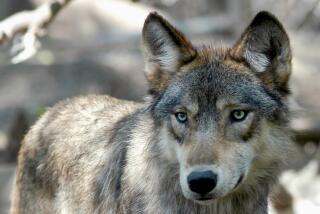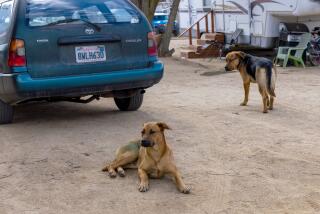New danger menaces Iraqis
SAMAWAH, IRAQ — The bloodthirsty enemy had gathered on the city’s perimeter, but this time the locals were ready.
They had formed armed committees similar to the “Sons of Iraq” forces fighting off Al Qaeda in Iraq militants in western Iraq. They were gearing up for a fight.
Their foes had been attacking them with increasing abandon on the outskirts of this river city 145 miles southeast of Baghdad. They struck along the harsh desert plain leading to Saudi Arabia. They came day or night.
Among children, supernatural powers were attributed to these adversaries. They could withstand intense cold, according to legend, and their eyes changed from yellow to orange to green.
There would be no mercy for this enemy. And no negotiations.
The enemy, after all, was packs of hungry gray wolves who had overcome their fears of humans and had begun feasting on livestock, right in front of farmers.
“The locals formed armed groups, exchanging shifts throughout the day in order to protect people, cattle, sheep, and also children and women heading to schools, from those ferocious wolves,” said Mohammed abu Reesha. “They appear during the day and don’t fear bullets and challenge even men holding rifles.”
The Arabian wolf, a subspecies of the gray wolf, is among the most impressive predators in the Middle East. It grows up to 6 1/2 feet long and stands as tall as 3 1/2 feet, weighing up to 120 pounds, said veterinarian Fahad abu Kaheela. It has powerful jaws and can sprint at speeds of 40 mph.
The wolves hunt strategically, organizing themselves into packs and communicating via howls at different tones. They’ve been prowling Iraq’s dusty wastelands for hundreds of years.
But something strange happened this year. Locals believe the wolves must have crossed some threshold of desperation or hunger, reached a tipping point that had prevented them from venturing onto human turf. They overcame their fear of people and began entering towns and villages to feast on sheep and cattle.
Animal experts say predatory beasts such as wolves overcome their fear of humans when they’re in close proximity to them. Some farmers speculated that the wolves had migrated from deserts to the villages because of three years of sparse rains and a lack of suitable prey. Others, including the local vet, said the incursions began after nomadic tribes began using high fences to protect their livestock.
“The wolves are fierce because of hunger and thirst that plagued them,” said Abu Kaheela, the vet. “That is why they began showing no fear.”
Children began likening the wolves to Saloueh, a witch in Iraqi fairy tales. Locals worried that the animals might attack women and children.
“I have passed 60 years and I have never seen such wolves!” exclaimed Ugla Mohammed, a farmer wearing a full ammunition belt and carrying a rifle in his hand. “They are vicious and stubborn grays.”
One old-timer, Fadhel abu Reesha, recalled that in the 1950s lone wolves were frequently spotted coming into villages, then escaping as they were confronted by farmers. They headed back, he said, into the barren lands near the Saudi border.
Today’s wolves, farmers said, seem more brazen.
Hussein Dakhel said a pack of a dozen wolves devoured five of his sheep, acting largely undisturbed as he fired gunshots into the air.
“We thought that wolves would run if they hear the sound of man or weapons,” he said. “I don’t know what kind of species this is.”
To fight the wolves, residents set up positions just beyond their hamlets and armed themselves with assault rifles and pistols. Determined fighters gathered at night, awaiting the wolf packs. They spread out in every direction. They waited and watched.
Mohammed abu Reesha, among the many residents belonging to the Abu Reesha clan, and his neighbors confronted a pack of 10 wolves after the animals attacked Adnan Ismael’s home, killing eight of his goats.
“We opened intense fire and killed two of them,” Mohammed abu Reesha said.
In the village of Hamidiya, wolves attacked farmer Mohammed Salim’s cows. He shot at one wolf from 100 yards away.
“I hit him, but he started coming toward me, not caring about his injury,” he said.
“I answered him, along with my uncle, with a barrage of bullets and he dropped dead two yards from us,” he said. “Since that day we are committed to guarding the house in case any of them might come back.”
A video taken by a cellphone shows the bloody remains of one wolf, its side shot out and its mouth draped open, lying lifeless on the desert floor. Its eyes, whatever the color at the time of death, were shut tight.
--
Special correspondent Halawa reported from Samawah and Times staff writer Daragahi from Baghdad.
More to Read
Sign up for Essential California
The most important California stories and recommendations in your inbox every morning.
You may occasionally receive promotional content from the Los Angeles Times.










